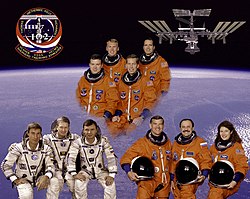 ICC (left) and the MPLM Leonardo (center) in Discovery's payload bay | |
| Names | Space Transportation System-102 |
|---|---|
| Mission type | ISS crew transport and resupply |
| Operator | NASA |
| COSPAR ID | 2001-010A |
| SATCAT no. | 26718 |
| Mission duration | 12 days, 19 hours, 49 minutes, 32 seconds |
| Distance travelled | 8,621,951 km (5,357,432 mi) |
| Orbits completed | 102 |
| Spacecraft properties | |
| Spacecraft | Space Shuttle Discovery |
| Launch mass | 99,503 kg (219,367 lb) |
| Landing mass | 90,043 kg (198,511 lb) |
| Payload mass | 5,760 kg (12,700 lb) |
| Crew | |
| Crew size | 7 |
| Members | |
| Launching | |
| Landing | |
| EVAs | 2 |
| EVA duration |
|
| Start of mission | |
| Launch date | 8 March 2001, 11:42:09 UTC (6:42:09 am EST) |
| Launch site | Kennedy, LC-39B |
| End of mission | |
| Landing date | 21 March 2001, 07:31:41 UTC (2:31:41 am EST) |
| Landing site | Kennedy, SLF Runway 15 |
| Orbital parameters | |
| Reference system | Geocentric orbit |
| Regime | Low Earth orbit |
| Perigee altitude | 370 km (230 mi) |
| Apogee altitude | 381 km (237 mi) |
| Inclination | 51.5° |
| Period | 92.1 minutes |
| Docking with ISS | |
| Docking port | Destiny forward |
| Docking date | 10 March 2001, 06:38 UTC |
| Undocking date | 19 March 2001, 04:32 UTC |
| Time docked | 8 days, 21 hours, 54 minutes |
 Mission patch  Top group, from left: Kelly, Thomas, Wetherbee and Richards Bottom left is the landing Expedition 1 crew, from left: Krikalev, Shepherd and Gidzenko Bottom right is the launching Expedition 2 crew, from left: Voss, Usachov and Helms | |
STS-102 was a Space Shuttle mission to the International Space Station (ISS) flown by Space Shuttle Discovery and launched from Kennedy Space Center, Florida. STS-102 flew in March 2001; its primary objectives were resupplying the ISS and rotating the Expedition 1 and Expedition 2 crews. It was Discovery's 29th flight. The first EVA performed on the mission, at eight hours and 56 minutes, held the title of the longest spacewalk ever undertaken until the 17th of December 2024 when it was surpassed by Cai Xuzhe and Song Lingdong during the Shenzhou 19 spaceflight.



